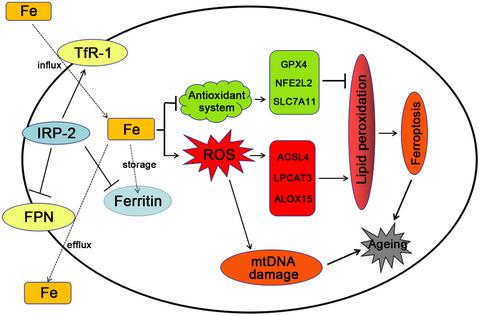Our official English website, www.x-mol.net, welcomes your feedback! (Note: you will need to create a separate account there.)
Relieving ferroptosis may partially reverse neurodegeneration of the auditory cortex.
The FEBS Journal ( IF 5.4 ) Pub Date : 2020-02-28 , DOI: 10.1111/febs.15266 Xi Chen 1 , Dan Li 1 , Hai-Ying Sun 1 , Wen-Wen Wang 1 , Han Wu 1 , Wen Kong 2 , Wei-Jia Kong 1
The FEBS Journal ( IF 5.4 ) Pub Date : 2020-02-28 , DOI: 10.1111/febs.15266 Xi Chen 1 , Dan Li 1 , Hai-Ying Sun 1 , Wen-Wen Wang 1 , Han Wu 1 , Wen Kong 2 , Wei-Jia Kong 1
Affiliation

|
Central presbycusis is caused by degradation of the auditory centre during ageing. Its main characteristics are difficulties in understanding language and localizing sound. Presbycusis is an increasingly critical public health problem, but the underlying molecular mechanism has not been fully elucidated. Ferroptosis is a form of regulated cell death caused by iron‐ and reactive oxygen species‐induced lipid peroxidation. Ferroptosis is related to many pathological processes, but whether it participates in the degeneration of the auditory system remains unclear. To investigate this, we measured iron levels in a simulated ageing model established by the addition of d‐galactose (d‐gal). We found, for the first time, that iron accumulated within cells and that the ultrastructural features of ferroptosis appeared in the auditory cortex with ageing. These changes were accompanied by upregulation of iron regulatory protein 2 (IRP‐2), which led to an increase in transferrin receptor 1 (TfR‐1), thus increasing iron entry into cells and potentially leading to ferroptosis. In addition, the malondialdehyde (MDA) content and the occurrence of mitochondrial DNA common deletions (CDs) increased, neuron degeneration appeared, and glutathione (GSH) and superoxide dismutase (SOD) activity decreased. Furthermore, we found that treatment with the iron chelator deferoxamine (DFO) and knockdown of IRP‐2 both relieved ferroptosis during the simulated ageing process, thus achieving a partial protective effect to delay ageing. In summary, we describe here the first discovery that age‐related iron deposition and ferroptosis may be associated with auditory cortex neurodegeneration. Relieving ferroptosis might thus be a new intervention strategy for age‐related hearing loss.
中文翻译:

减轻肥大症可以部分逆转听觉皮层的神经变性。
中枢性老花眼是由衰老过程中听觉中心的退化引起的。它的主要特征是难以理解语言和本地化声音。老年性耳聋是一个日益严重的公共卫生问题,但是其潜在的分子机制尚未得到充分阐明。Ferroptosis是一种由铁和活性氧引起的脂质过氧化作用导致的调节性细胞死亡形式。Ferroptosis与许多病理过程有关,但尚不清楚它是否参与听觉系统的退化。为了对此进行研究,我们在通过添加d-半乳糖(d-gal)。我们首次发现,铁会在细胞内积累,并且随着年龄的增长,听觉皮层中会出现铁锈病的超微结构特征。这些变化伴随着铁调节蛋白2(IRP-2)的上调,从而导致转铁蛋白受体1(TfR-1)的增加,从而增加了铁进入细胞的数量,并可能导致铁肥大病。此外,丙二醛(MDA)含量和线粒体DNA常见缺失(CDs)的发生增加,神经元变性出现,谷胱甘肽(GSH)和超氧化物歧化酶(SOD)活性降低。此外,我们发现,在模拟老化过程中,用铁螯合剂去铁胺(DFO)和敲除IRP-2均可缓解肥大症,从而达到部分保护作用,延缓衰老。综上所述,我们在此描述的第一个发现是年龄相关的铁沉积和铁质增生可能与听觉皮层神经变性有关。因此,缓解肥大症可能是针对与年龄相关的听力损失的新干预策略。
更新日期:2020-02-28
中文翻译:

减轻肥大症可以部分逆转听觉皮层的神经变性。
中枢性老花眼是由衰老过程中听觉中心的退化引起的。它的主要特征是难以理解语言和本地化声音。老年性耳聋是一个日益严重的公共卫生问题,但是其潜在的分子机制尚未得到充分阐明。Ferroptosis是一种由铁和活性氧引起的脂质过氧化作用导致的调节性细胞死亡形式。Ferroptosis与许多病理过程有关,但尚不清楚它是否参与听觉系统的退化。为了对此进行研究,我们在通过添加d-半乳糖(d-gal)。我们首次发现,铁会在细胞内积累,并且随着年龄的增长,听觉皮层中会出现铁锈病的超微结构特征。这些变化伴随着铁调节蛋白2(IRP-2)的上调,从而导致转铁蛋白受体1(TfR-1)的增加,从而增加了铁进入细胞的数量,并可能导致铁肥大病。此外,丙二醛(MDA)含量和线粒体DNA常见缺失(CDs)的发生增加,神经元变性出现,谷胱甘肽(GSH)和超氧化物歧化酶(SOD)活性降低。此外,我们发现,在模拟老化过程中,用铁螯合剂去铁胺(DFO)和敲除IRP-2均可缓解肥大症,从而达到部分保护作用,延缓衰老。综上所述,我们在此描述的第一个发现是年龄相关的铁沉积和铁质增生可能与听觉皮层神经变性有关。因此,缓解肥大症可能是针对与年龄相关的听力损失的新干预策略。



























 京公网安备 11010802027423号
京公网安备 11010802027423号